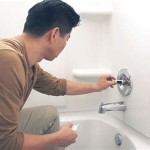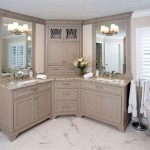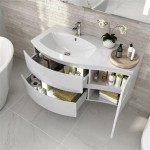Angled Bathroom Sinks
Angled bathroom sinks offer a unique blend of style and space-saving functionality, making them an increasingly popular choice for modern bathrooms. Their distinct slanted design allows for optimal corner placement, freeing up valuable floor space while maintaining essential washing capabilities. This article delves into the various aspects of angled bathroom sinks, covering their benefits, materials, installation considerations, and design options.
Benefits of Angled Bathroom Sinks
Angled sinks provide a range of advantages for homeowners looking to maximize their bathroom space:
- Space Optimization: The primary benefit is their ability to efficiently utilize corner space, often underutilized in traditional bathroom layouts.
- Enhanced Accessibility: In smaller bathrooms, angled sinks can improve traffic flow and create a less cramped environment.
- Unique Aesthetic: The angled design offers a contemporary and visually appealing alternative to standard rectangular sinks.
Materials Used for Angled Bathroom Sinks
Angled sinks are available in a variety of materials, each offering distinct aesthetic and practical properties:
- Porcelain: A classic and durable choice, porcelain is resistant to staining and chipping, offering a smooth, easy-to-clean surface.
- Vitreous China: Similar to porcelain, vitreous china is highly durable and stain-resistant, often more cost-effective.
- Fireclay: Known for its exceptional durability and resistance to high temperatures and impacts, fireclay offers a long-lasting option.
- Glass: Glass sinks provide a modern and elegant look, available in various colors and textures to complement different bathroom styles.
- Stone Resin: Composed of crushed stone and resin, stone resin sinks are highly durable, non-porous, and resistant to scratches and stains.
- Metal: Stainless steel and copper sinks offer a sleek and contemporary aesthetic, known for their durability and resistance to corrosion.
Installation Considerations for Angled Bathroom Sinks
Proper installation is crucial for the functionality and longevity of an angled bathroom sink. Several factors should be considered:
- Plumbing: Ensure existing plumbing lines are compatible with the chosen sink's configuration or be prepared to adjust them accordingly.
- Wall Support: Adequate wall support is essential, particularly for heavier materials like stone or fireclay.
- Countertop Compatibility: If installing an undermount or vessel sink, ensure the countertop material and dimensions are suitable.
- Corner Fit: Accurate measurements are critical to ensure a precise fit within the designated corner space.
Design Options for Angled Bathroom Sinks
Angled bathroom sinks come in a wide array of styles and configurations to suit various design preferences:
- Pedestal Sinks: These freestanding options offer a classic and elegant look, suitable for smaller bathrooms.
- Wall-Mounted Sinks: Maximizing floor space, wall-mounted angled sinks provide a contemporary and minimalist aesthetic.
- Corner Vanity Units: Combining storage with the sink, corner vanity units offer a practical and stylish solution.
- Vessel Sinks: Sitting atop the counter, vessel sinks create a dramatic focal point, often paired with unique faucet designs.
- Undermount Sinks: Integrated seamlessly beneath the countertop, undermount sinks provide a clean and modern look, simplifying countertop cleaning.
Choosing the Right Faucet for an Angled Sink
Faucet selection plays a significant role in the functionality and aesthetics of an angled bathroom sink:
- Wall-Mounted Faucets: Ideal for wall-mounted sinks, freeing up counter space.
- Deck-Mounted Faucets: Installed directly on the sink or countertop, offering a variety of styles.
- High-Arc Faucets: Provide ample clearance for washing hands and filling containers.
- Single-Handle Faucets: Offer convenient single-lever control for water temperature and flow.
Maintenance and Care
Proper maintenance ensures the longevity and appearance of an angled bathroom sink:
- Regular Cleaning: Wipe down the sink surface after each use with a mild cleanser to prevent buildup.
- Avoid Abrasive Cleaners: Harsh chemicals and abrasive cleaners can damage the sink's finish.
- Check for Leaks Promptly: Address any leaks immediately to prevent water damage.
- Clean Drain Regularly: Remove hair and debris from the drain to prevent clogs.
Accessibility and Universal Design
Angled sinks can contribute to creating a more accessible bathroom environment:
- Enhanced Maneuverability: The angled design can improve wheelchair access and provide more space for individuals with mobility limitations.
- Wall-Mounted Options: Wall-mounted angled sinks allow for adjustable height installation, catering to individual needs.
- Lever-Style Faucets: Easier to operate than traditional knob handles, lever-style faucets improve accessibility.

Copper Sinks Naturally Popular Corner Sink Bathroom Small Inspiration

Corner Bathroom Sinks Creating Space Saving Modern Design Top Inspiration House Designs

Twin Star Home 25 In W X D Corner Bathroom Vanity Antique Gray With White Top And Basin 25bv35043 Pg22 The Depot

Wall Mounted 60cm Contemporary Sloping Rectangular Basin Nero

Cerastyle 001300 U By Nameek S Mini Small Corner Ceramic Wall Mounted Or Vessel Sink Thebath

Scarabeo 8007 E Bathroom Sink Square Nameek S

Corner Sink With Backsplash Powder Room Bathroom Vanity Beautiful Bathrooms

24 Benton Collection Thomasville Taupe Modern Corner Bathroom Vanity Bentoncollections

Corner Bathroom Vanity Ideas My Renovations

20 White Floating Small Corner Bathroom Vanity With Ceramics Single Vessel Sink Homary Ca
Related Posts







